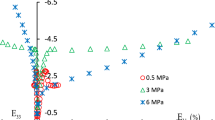Abstract
In the present work, which consists of three parts, we make an attempt to formulate the fundamental ideas of the theory of quasibrittle fracture of polycrystalline metals and structural alloys on the macroscopic and microscopic levels. Within the framework of the usual approach, we consider physical aspects of the problem of analysis of the elementary acts of fracture of the crystal lattice and regularities of macroscopic fracture under conditions of stress concentration in connection with the problem of structural integrity. We propose simple and convenient practical criteria of quasibrittle fracture under conditions of stress concentration and formulate physically substantiated concepts of the ductility of metals. In the first part of the work, we present the results of the experimental investigation of the fracture of specimens with stress concentrators of various geometries and fatigue cracks, establish the regularities of changes in the local characteristics of fracture, and analyze the principal factors affecting the value of the critical cleavage stress σf.
Similar content being viewed by others
References
T. Yokobori,Fundamentals of Strength and Fracture of Materials [Russian translation], Naukova Dumka, Kiev (1978).
Yu. Ya. Meshkov and T. N. Serditova,Fracture of Deformed Steel [in Russian], Naukova Dumka, Kiev (1989).
J. F. Knott,Fundamentals of Fracture Mechanics, Butterworths, London (1973).
S. A. Kotrechko, Yu. Ya. Meshkov, and G. S. Mettus, “Brittle fracture of polycrystalline metals in complicated stressed states,”Metallofizika,10, No. 6, 46–55 (1988).
S. A. Kotrechko, “The critical cleavage stress and ‘brittle strength’ of polycrystalline metals,”Phys. Met.,12, No. 5, 542–548 (1993).
G. P. Karzov, B. Z. Margolin, and V. A. Shvetsova,Physicomechanical Simulation of Fracture Processes [in Russian], Politekhnika, Sanit Petersburg (1993).
J. Knott, “Influence of the depth of the notch on resistance of soft steel to brittle fracture,” in: Yu. N. Rabotnov (ed.),New Methods for the Estimation of the Resistance of Metals to Brittle Fracture [Russian translation], Mir, Moscow (1972), pp. 181–197.
G. V. Uzhik,Tear Resistance and Strength of Metals [in Russian], Academy of Sciences of the USSR, Moscow (1950).
L. A. Kopel’man,Resistance of Welds to Brittle Fracture [in Russian], Mashinostroenie, Leningrad (1978).
Ya. M. Potak,Brittle Fracture of Steel and Steel Products [in Russian], Oborongiz, Moscow (1955).
K. S. Kuhne and W. A. Dahl, “Einflus des spannungz ustandes und des Gefuges auf die Spaltbrunch—spannung von baustahlen,”Arch. Eisenhuttenwes,54, No. 11, 439–440 (1983).
G. S. Pisarenko and A. A. Lebedev,Strain and Strength of Materials in Complicated Stressed States [in Russian], Naukova Dumka, Kiev (1976).
S. A. Kotrechko and Yu. Ya. Meshkov, “Influence of the three-dimensional stressed state on the flow of iron and carbon steels. Part 1. Physical model of flow in the complicated stressed state,”Probl. Prochn., No. 11, 3–7 (1994).
S. A. Kotrechko, Yu. Ya. Meshkov, and G. S. Mettus, “Influence of the three-dimensional stressed state on the flow of iron and carbon steels. Part 2. Experimental investigation of low-temperature plastic deformation of 45 steel under triaxial tension,”Probl. Prochn., No. 11, 8–13 (1994).
N. S. Kogut,Crack Resistance of Structural Materials [in Russian], Vyshcha Shkola, Lvov (1986).
Yu. Ya. Meshkov,Physical Foundations of Fracture of Steel Structures [in Russian], Naukova Dumka, Kiev (1981).
Yu. Ya. Meshkov and G. A. Pakharenko,Structure of Metals and Brittleness of Steel Products [in Russian], Naukova Dumka, Kiev (1985).
S. A. Kotrechko, Yu. Ya. Meshkov, and G. S. Mettus, “On the physical nature of the strength of polycrystalline metals for temperatures of ductile-brittle transition,”Metallofiz. Noveish. Tekhnol.,16, No. 12, 39–43 (1996).
Additional information
Institute of Physics of Metals, National Academy of Sciences of Ukraine, Kiev, Ukraine. Translated from Problemy Prochnosti, No. 4, pp. 5–16, July–August, 1997.
Rights and permissions
About this article
Cite this article
Kotrechko, S.A., Meshkov, Y.Y., Nikonenko, D.I. et al. Mechanics and physics of quasibrittle fracture of polycrystalline metals under the conditions of stress concentration. Part I. Experimental results. Strength Mater 29, 319–327 (1997). https://doi.org/10.1007/BF02767814
Received:
Issue Date:
DOI: https://doi.org/10.1007/BF02767814




